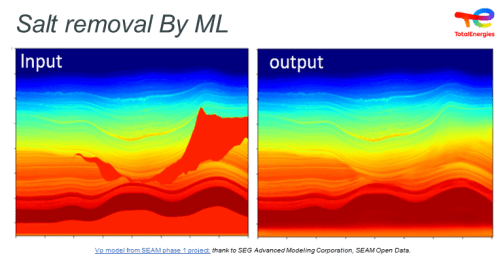Workshop 3
Artificial Intelligence (AI) for Seismic Processing and Reservoir characterization: a game changer? Sunday, June 1st | Room 7 (Level 2)
Convenors
- Laurent Lemaistre (TotalEnergies)
- Thierry Cadoret (TotalEnergies)
- Yen Sun (TotalEnergies)
- Guillaume Poulain (Viridien)
- Mikhail Baturin (TotalEnergies)
Description
The integration of Artificial Intelligence (AI) into seismic processing and reservoir characterization is now a reality at all stages of E&P and New energies workflows. This workshop will focus on the use of AI techniques at all stages of the seismic processing sequence, including reservoir characterization, paying particular attention to inversion.
It will showcase AI applications that improve the accuracy and efficiency of our seismic workflows. It will assess the benefits of AI-driven approaches by comparing them with the more conventional tools that they are designed to replace, in terms of quality of results and overall computational and human effort.
The workshop will also explore the potential of applying emerging machine learning technologies, for example, generative AI, seismic foundation models and LLM-like architectures to improve geophysical inversion and imaging.
A round table session will be organized to develop actionable recommendations and strategies for integrating AI more effectively in our workflows.
The workshop will be divided into three main parts, each focusing on a specific aspect of AI applications:
- AI for Seismic Processing: This session will review the current applications of AI within seismic processing for both active and passive seismic data. Participants will explore how machine learning technologies can enhance seismic imaging. Topics will include image processing (denoising), image segmentation (picking), and seismic event detection.
- AI for Velocity Model Building: This part will focus on the use of AI in building velocity models, which are crucial for accurate seismic imaging and interpretation. The session will cover various AI techniques used to improve the accuracy and efficiency of velocity model building, comparing them with traditional methods.
- AI for Quantitative Interpretation: The final session will delve into the applications of AI for quantitative interpretation, which involves analyzing seismic data to predict rock properties and hydrocarbon distribution. The workshop will highlight how AI can enhance the accuracy and reliability of quantitative interpretation, comparing it with conventional tools such as seismic inversion and AVO analysis.
The last phase of the workshop will be dedicated to defining the main learnings from the day and drawing conclusions to identify directions for improvement in the future. This session will provide an opportunity for participants to reflect on the insights gained throughout the workshop and discuss how these can be applied, pinpointing challenges that remain to be addressed.
Join us to discover the future of seismic processing and reservoir characterization through the lens of Artificial Intelligence!

Participant Profile
This workshop is designed for geoscientists with experience in processing/imaging, elastic inversion and/or applying machine learning to seismic data.
The goal of the workshop is to bring together technical experts from industry, service providers and research institutions to discuss AI integration in seismic processing and quantitative interpretation.
We invite participants to contribute their experiences (success stories and challenges) in the form of case studies for discussion, including business objectives, feasibility assessment, workflows, interpretation results and remaining uncertainties
Workshop Programme
| Time | Activity |
|---|---|
| 09:00 | Workshop Introduction: Welcome by Co-Chairs and Workshop |
| 09:05 | Session 1 Introduction - Viridien |
| 09:10 | Session 1a: Seismic processing, Velocity Model building and UQ |
| Distributed Acoustic Sensing Instrumental Noise removal: Machine Learning Approaches, Olivia Collet (Curtin University) | |
| Seismic processing and machine learning: what is my data space distribution?, Laurent Lemaistre (TotalEnergies) | |
| The Contribution of Active Learning for Seismic QC, Guillaume Poulain (Viridien) | |
| AI-Driven Automatic Quality Control and Parameterization in Deep Water Seismic Processing, Harry Rynja (Shell) | |
| Accelerating Seismic time processing and Model Building with Machine Learning, Alejandro Valenciano (TGS) | |
| 10:50 | Session 1a: Q&A |
| 11:00 | Coffee Break |
| 11:15 | Session 1b: Seismic processing, Velocity Model building and UQ |
| Using generative models for seismic processing and velocity model building, Tariq Alkhalifah (KAUST) | |
| Seismic Image Super-Resolution with Sparse Wells, Aria Abubakar (SLB) | |
| Development and Evolution of Machine Learning Workflows for Seismic Interpretation, Maisha Amaru (Chevron) | |
| Generative AI for seismic imaging: uncertainty quantification and inference, Yuke XIE (Mines Paris) | |
| 12:35 | Session 1b: Q&A |
| 12:45 | Lunch |
| 13:45 | Session 2 Introduction: TotalEnergies |
| 13:50 | Session 2a: Predict rock properties and hydrocarbon distribution: Integration of seismic together with well logs, and other data, log prediction. Comparisons with Seismic inversion, AVO Analysis |
| Deep Learning Seismic Inversion: Quantifying Uncertainty, Konstantin Osypov (Halliburton) | |
| Integrating QI automation and ML workflows for accelerating subsurface rock-properties prediction, Andrea Murineddu (SLB) | |
| Unravelling the Unknown: Advancing Seismic Reservoir Characterization with Machine Learning, Tanya Colwell (Geosoftware) | |
| Foundation Models and Physics- Informed Neural Networks in Reservoir Characterization, Dimitrios Oikonomou (ESA) | |
| 15:10 | Session 2a: Q&A |
| 15:20 | Coffee Break |
| 15:35 | Session 2b: Predict rock properties and hydrocarbon distribution: Integration of seismic together with well logs, and other data, log prediction. - Comparisons with Seismic inversion, AVO Analysis |
| AI-Driven Elastic and Reservoir Property Estimation: Bridging Deep Learning and Physics-Based Approaches, Asmund Heir (RagnaRock) | |
| Adaptation of Deep Neural Network flows for quantitative interpretation of subsurface reservoirs, Jean-Luc Formento (Viridien) | |
| Maximizing field development through rock physics informed hi- res ML seismic estimates of reservoir properties, Benjamin Roure (Parex) | |
| 16:35 | Session 2b: Q&A |
| 16:45 | Q&A and way forward |
| 17:35 | End of the Workshop |


